Introduction
The paper seeks to provide a descriptive analysis of the various indicators that relate to the foreign-born Japanese in the United States. Some of the indicators that will be discussed are demographics, age distribution and marital status, education, labour force participation, earnings, and housing status and medical insurance of the population. The data for the analysis will be obtained from reports of American Community Survey (United States Census Bureau 1).
Demographics
The population of the foreign-born Japanese in the United States it quite low in relation to the total population foreign-born in the United States of America. The total number of Japanese is 0.11% of the total population of the United States.
However, the population of the foreign-born Japanese in the United States is 0.85%. Further, the population of the native-born is 0.01%. This shows that the percentage of the foreign-born Japanese in the United States is dismal (United States Census Bureau 1).
Figure 1.: Percentages of the foreign-born Japanese in the United States
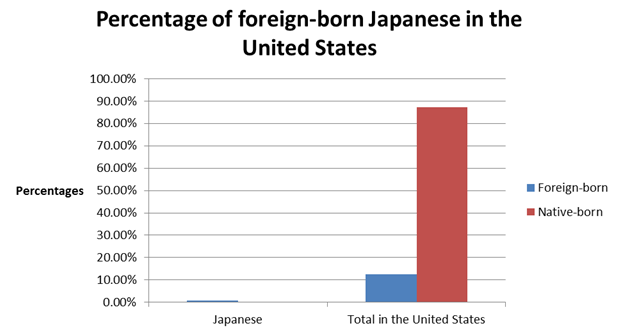
Under the demographics, it can also be observed that the proportion of Japanese citizens and non-citizens are quite low in relation to the total population of the foreign-born in the United States.
The Japanese citizens are 0.68% of the total number of foreign-born citizens while the proportion of the non-citizens is 1.11%. The percentages show that a large proportion of the foreign-Japanese are non-citizens (United States Census Bureau 1).
Figure 1.1: Proportion of citizens and non-citizens
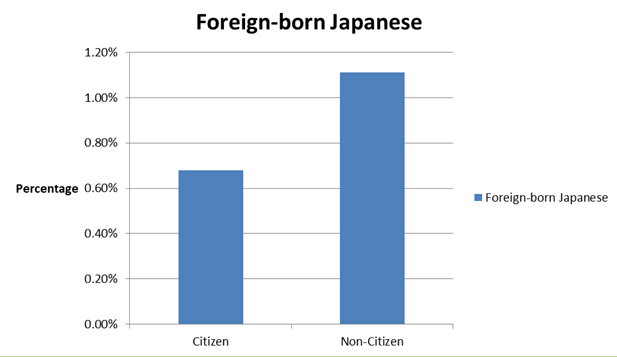
Age distribution
Based on the data collected, 34.5% of the population are male while 65.5% of the population are female. The total population of the foreign-born in the United States comprises 49.1% male and 50.9% female (United States Census Bureau 1).
Figure 1.2: Sex distribution of the foreign-born Japanese
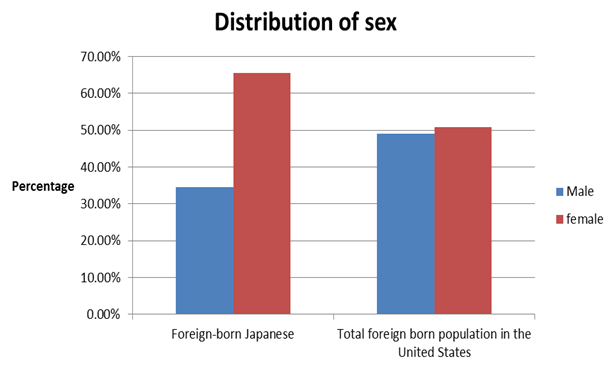
The graph shows that there is a high proportion of female foreign-born Japanese in the United States as compared to the proportion of women in the total population of the foreign-born in the United States. A large proportion (23.2%) of the population of the foreign-born Japanese lies between 35 to 44 years. Age group 45 to 54 years follows closely at 16.9%.
However, only 1.6% of the population falls below five years old. Further, statistics show that foreign-born Japanese in the United States has a slightly higher median age when compared to the total population of the foreign-born in the United States. The median age for the foreign-born Japanese is 41.9 years while the median age for the foreign-born in the United States is 40.2 years (United States Census Bureau 1).
Figure 1.3: Comparison of the median age among the foreign-born Japanese
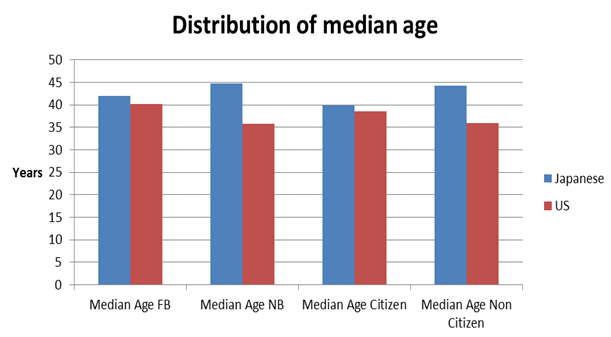
Based on the graph above, it can be observed that the median age for the foreign-born Japanese is higher than the population of foreign-born in the United States. This can be attributed to the fact that over 86% of the foreign-born Japanese are more than 34 years old. Further, it can be observed that the median age for the native-born Japanese is higher than the media age for the foreign born.
Further, analysis of the population indicates that 53.6% of the foreign-based Japanese are family households. The remaining 46.4% are non-family households. Further, the statistics show that the family households with own children under the age of 18 are 24.8% while married couple with own children under the age of 18 are 20.8%.
Further, the proportion of non-family households with male householders are 17.8%, male householders living alone are 15.2%, male householders not living alone are 2.6%, female householders are 28.7%, female householders living alone are 25.8% while female householders not living alone are 2.9%. The statistics show that the households of the foreign-born Japanese are distributed under different varieties.
The statistics also show that the proportion of non-family female householders is higher than the non-family male householders. This can be attributed to the fact that the proportion of female foreign-born Japanese is higher than the proportion of males. Thus, the distribution of sex has an impact on other demographic variables (United States Census Bureau 1).
Marital status
Statistics show that the proportion of the foreign-born Japanese married is 62.3%. The value is higher than the percentage of the total foreign-born in the United States (48.5%). Besides, the statistics show that a large number of foreign-born Japanese are married in relation to the native-born Japanese.
Further, the data show that the proportion of non-citizen Japanese that are married is higher than that of the Japanese citizens in the United States. This can be attributed to the fact that the total proportion of non-citizens Japanese is higher than the citizens.
However, the proportion of married foreign-born Japanese is quite low when compared to the foreign-born in the United States. The high proportion of the married foreign-born Japanese can be attributed to the fact that a large proportion of the Japanese population is the United States is older than the proportion of the foreign-born in the United States.
The data also show that a large number of female foreign-born Japanese are married (126,225) when compared to the male (64,083). This can be attributed to the high population of female in relation to the male (United States Census Bureau 1).
Figure 1.4: Distribution of the married foreign-born Japanese in the United States
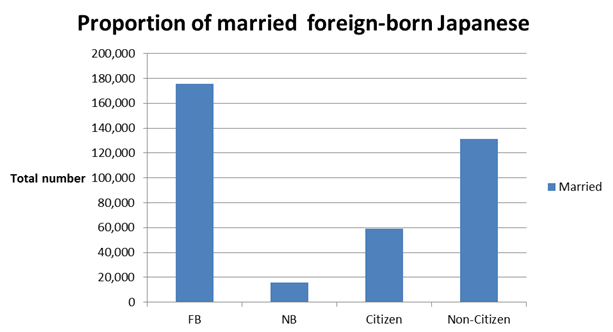
Education
The statistics show that a large population of the foreign-born Japanese has attained less than a high school education and bachelor’s degree and above. A small proportion of the population has attained high school and college.
The distribution is different from the other foreign-born in the United States because a small proportion of the population has less than high school while the largest proportion have attained some college. A similar proportion has also attained some college and bachelor’s degree and above (United States Census Bureau 1).
Figure 1.5: Distribution of education among the foreign-born Japanese in the United States
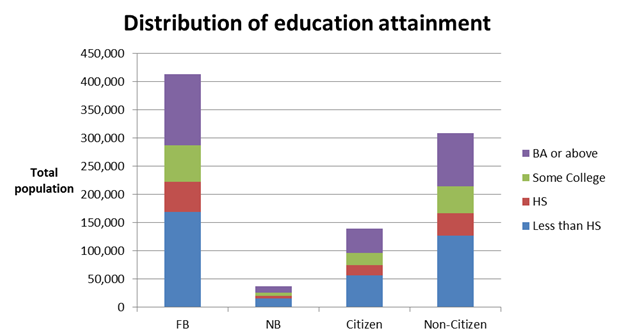
Thus, it can be observed that families of the foreign-born Japanese in the United States are focusing on educating their children to attain bachelor degree and above. This can be the population that earns a high income. The lower end of income bracket can barely educate their children.
This explains why there is also a large proportion of the population of foreign-born Japanese who are less educated. Further, statistics show that the proportion of males who have attained higher education (96.4%) is higher than the proportion of female who have attained higher education (92.1%).
Further, the proportion of males who have attained a bachelor’s degree is higher (66.0%) than the percentage of females who have attained a bachelor’s degree (39.9%).
Further, the school enrollment for nursery school stand at 4.7%, kindergarten at 2.7%, elementary school at 23.1%, high school at 9.1% and college stands at 60.4%. The distribution of school enrollment also indicates that the population of the foreign-born Japanese contains a small percentage of young people (United States Census Bureau 1).
Labour force participation
A large proportion of the Japanese population is in labour force in the United States. The statistics show that 54.7% of the population is in the labour force while 45.3% are not in the labour force. Out of the 54.7%, 52.2% of the population is employed while 2.5% are unemployed.
Further, 0.1% is engaged in the armed forces. The proportion of females in the labour force is 43.1% while 56.9% are male in the labour force (United States Census Bureau 1).
Figure 1.5: Distribution of labour force among the foreign-born Japanese in the United States

Further, the proportion of the population of foreign-born Japanese who are unemployed is quite low in relation to the total number of foreign-born in the United States.
The total number of unemployed foreign-born Japanese is 7,016 while the total population of unemployed foreign-born living in the United States is 16,092,740. This shows that a very small percentage of the foreign-born Japanese are unemployed in relation to the total population of the foreign-born 0.044%.
Earnings
The total income for the past 12 months for the households of the foreign-born Japanese was $137,225 while the median household income was $56,879. Further, the median family income in the past twelve months was $73,487. The data also reveal that the per capita of the foreign-born Japanese in the United States was $37,357.
The distribution of earnings also shows that the median earnings for male full-time, year round workers was higher than the ($72,563) the earnings for the female ($44,067).
Housing status and medical insurance
Statistics show that the total population of the civilian non-institutionalizes foreign-born Japanese was 324,152. 83.6% of the population have private insurance, 21.1% of the population have public coverage while 9.3% of the population do not have insurance coverage. Thus, over 90% of the population has insurance coverage (United States Census Bureau 1).
Works Cited
United States Census Bureau, 2013, American Community Survey. Web.